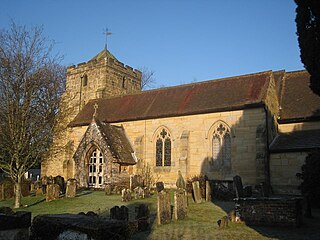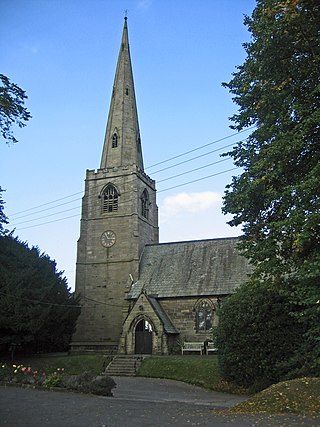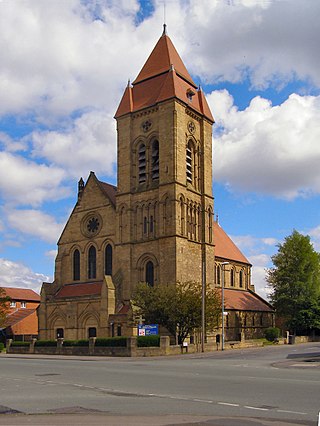
Crouch End is an area of North London, approximately five miles (8 km) from the City of London in the western half of the borough of Haringey. It is within the Hornsey postal district (N8). It has been described by the BBC as one of "a new breed of urban villages" in London. It was recently voted the best place to live in London by the Sunday Times, who said, "A creative edge and friendly neighbours give this lofty northern enclave social capital in the capital".

The Philharmonic Dining Rooms is a public house at the corner of Hope Street and Hardman Street in Liverpool, Merseyside, England, and stands diagonally opposite the Liverpool Philharmonic Hall. It is commonly known as The Phil. It is recorded in the National Heritage List for England as a designated Grade I listed building.

Ullet Road Church is a Unitarian church at 57 Ullet Road, Sefton Park, Liverpool. Both the church and its attached hall are separately recorded in the National Heritage List for England as designated Grade I listed buildings. It was the first place of worship in the United Kingdom to register a civil partnership for a same-sex couple. It is a member of the General Assembly of Unitarian and Free Christian Churches, the umbrella organisation for British Unitarians.

Sedlescombe is a village and civil parish in the Rother district of East Sussex, England. The village is on the B2244 road, about 6 miles (10 km) north of Hastings. The parish includes the hamlet of Kent Street, which is on the A21 road.

Wonersh is a village and civil parish in the Waverley district of Surrey, England and Surrey Hills Area of Outstanding Natural Beauty. Wonersh contains three Conservation Areas and spans an area three to six miles SSE of Guildford.

The Salisbury is a Grade II* listed pub on Grand Parade in Harringay, North London.

The Edgar Wood Centre is a former Church of Christ, Scientist building in Victoria Park, Manchester, England. The church was designed by Edgar Wood in 1903. Nikolaus Pevsner considered it "the only religious building in Lancashire that would be indispensable in a survey of twentieth century church design in all England". It is a Grade I listed building and has been on the Heritage at Risk Register published by Historic England.

St John the Evangelist's Church is located to the north of the village of Ashton Hayes, Cheshire, England. It is an active Anglican parish church in the diocese of Chester, the archdeaconry of Chester and the deanery of Chester. The church is recorded in the National Heritage List for England as a designated Grade II listed building.
Henry Gustave Hiller (1865–1946) was an artist based in Liverpool, England. He studied at the Manchester School of Art and is mainly known as a designer of painted gesso reliefs and stained glass.

The Glass House building was a "purpose-built stained-glass studio and workshop" for stained glass artists in Fulham, London. Having gone into partnership in 1897, Mary Lowndes and Alfred Drury had The Glass House built in 1906 for use by independent stained-glass artists.

Rose Hill in Longley Lane, Northenden, Manchester, England, is a 19th-century Victorian villa. It is most notable as the home of Sir Edward Watkin, "railway king and cross-channel visionary", and in the late 20th century it was in use as a children’s home.

The former National Westminster Bank in Spring Gardens, Manchester, England, is an Edwardian bank building constructed in 1902 for Parr's Bank by Charles Heathcote. The bank is in a "bold Edwardian Baroque" style. It is a Grade II* listed building as of 25 February 1952.

The Church of St John the Evangelist is in Waterloo Road, Cheetham Hill, Manchester, England. It is an active Anglican parish church in the deanery of North Manchester, the archdeaconry of Manchester, and the diocese of Manchester. The church is recorded in the National Heritage List for England as a designated Grade II* listed building.
Grove Park is an area in the south of Chiswick, now in the borough of Hounslow, West London. It lies in the meander of the Thames occupied by Duke's Meadows park. Historically, the area belonged to one of the four historic villages in modern Chiswick, Little Sutton. It was long protected from building by the regular flooding of the low-lying land by the River Thames, remaining as orchards, open fields, and riverside marshland until the 1880s. Development was stimulated by the arrival of the railway in 1849; Grove Park Hotel followed in 1867, soon followed by housing.

The Crouch End Hippodrome, originally the Queen's Opera House, was a theatre that once stood in Tottenham Lane, Crouch End, London.

Neville Lumb are a supplier of commercial sanitaryware, part of the Saint-Gobain group.

Tottenham Lane is a street in Crouch End and Hornsey in the London Borough of Haringey. The street runs from the centre of Crouch End at the clock tower, north to the junction of the High Street and Turnpike Lane (A504).

The Cathedral of the Nativity of Our Lord is a Georgian Orthodox church located on the border of Upper Clapton and Stamford Hill, London. Since its opening in 1892 as the Agapemonite Church of the Ark of the Covenant it has served as the sole London outpost of three very different Christian denominations. During the second half of the twentieth century it was the Church of the Good Shepherd and belonged to the Ancient Catholic Church, a now defunct denomination. In 2011 it became a Georgian Orthodox Cathedral and gained its current name. It is a Grade II* listed building, in part because of its exceptional Arts and Crafts stained glass windows but also as the former headquarters of a late-Victorian Christian cult.





















